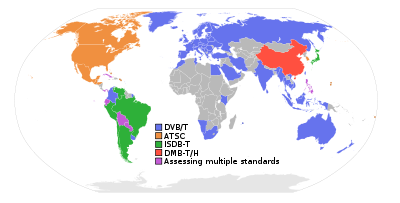- Digital Terrestrial Multimedia Broadcast
-
List of digital television broadcast standards DVB standards (Europe) DVB-S (satellite) DVB-T (terrestrial) DVB-C (cable) DVB-H (handheld) - DVB-SH (satellite)
ATSC standards (North America/Korea) ATSC (terrestrial/cable) ATSC-M/H (mobile/handheld) ISDB standards (Japan/Latin America) ISDB-S (satellite) ISDB-T (terrestrial) ISDB-C (cable) SBTVD/ISDB-Tb (Brazil) DTMB standards (China) DTMB-T/H (terrestrial/handheld) CMMB (handheld) DMB standards (Korean handheld) T-DMB (terrestrial) S-DMB (satellite) MediaFLO Codecs Video Audio Frequency bands VHF UHF SHF DTMB (Digital Terrestrial Multimedia Broadcast) is the TV standard for mobile and fixed terminals used in the People's Republic of China, Hong Kong and Macau. Although at first this standard was called DMB-T/H (Digital Multimedia Broadcast-Terrestrial/Handheld), the official name is DTMB.
DTT broadcasting systems. Countries using DTMB or DMB-T/H are shown in red.
Contents
Overview
The DTMB is a merger of the following standards: ADTB-T (developed by the Shanghai Jiao Tong University, Shanghai), DMB-T (developed by Tsinghua University, Beijing) and TiMi (Terrestrial Interactive Multiservice Infrastructure), which is the standard proposed by the Academy of Broadcasting Science in 2002.
At first, neither Shanghai Jiao Tong University nor Tsinghua had not enough political strength to make their own technology being the unique standard, so the final decision was to opt for a double standard, merged with theTIMI 3 standard, responding to a need of backward compatibility.
The DTMB was created in 2004 and finally became an official DTT standard in 2006.
DTMB in China
- 2005 trial
- 18/08/2006 formal adoption as a DTT standard
- 2008 analogue to digital switchover
- 2015-2018 analog switchoff
DTMB in Hong Kong
- 18/08/2006 formal adoption as a DTT standard
- 31/12/2007 analogue to digital switchover
- 2015 analogue switchoff
DTMB in Macau
- 18/08/2006 formal adoption as a DTT standard
Versus CMMB
See China Multimedia Mobile Broadcasting (CMMB).
Countries and territories using DTMB
Asia
Middle East
Description
Besides the basic functions of traditional television service, the DTMB allows additional services using the new television broadcasting system. DTMB system is compatible with fixed reception (indoor and outdoor) and mobile digital terrestrial television.
- Mobile reception: is compatible with digital broadcasting TV in standard definition (SD), digital audio broadcasting, multimedia broadcasting and data broadcasting service.
- Fixed reception: in addition to the previous services, also supports high definition digital broadcasting (HDTV).
Modulation
The DTMB standard uses many advanced technologies to improve their performance, for example, a pseudo-random noise code (PN-Pseudo-random Noise) as a guard interval that allows faster synchronization system and a more accurate channel estimation , LDPC (Low-Density Parity-Check) encoding to protect against mistakes, modulation TDS-OFDM (Time Domain Synchronization - Orthogonal Frequency Division Multiplexing) which allows the combination of broadcasting in SD, HD and multimedia services, etc.
This system gives flexibility to the services offered to support the combination of Single Frequency Networks (SFN) and Multiple Frequency Network (MFN). The different modes and parameters can be chosen depending on the type of service and network's environment.
The sequence of pseudo-random pattern is defined in time domain and the information of the Discrete Fourier Transform (DFT) is defined in the frequency domain. The two frames are multiplexed in the time domain, resulting in the Time Domain Synchronization (TDS).
Functional scheme
This transmission system makes the conversion of the input signal to the output data of terrestrial TV signal.
The data passes through the encoder, the error protection process FEC (Forward Error Correction), through the constellation mapping process and then the interleaving processes the information to create the data blocks. The data block and the TPS information are multiplexed, and pass through the data processor to form the body structure. It combines information from the body and the head to form the frame and this is passed through the SRRC (Square Root Raised Cosine) filter to become a signal within a 8MHz channel bandwidth. Finally the signal is modulated to put it in the corresponding frequency band.
Features
- Bit-rate: from 4.813Mbps to 32.486Mbps
- Combination of SD, HD, and multimedia services
- Flexibility of services
- Time and frequency domain of data-processing
- Broadcasting of between 6 and 15 SD channels and 1 or 2 HD channels
- Same quality of reception as wire broadcast
Further reading
- Kumar, Amitabh (2007). Mobile TV: DVB-H, DMB, 3G Systems and Rich Media Applications. Focal Press Media Technology Professional Series. Focal Press. ISBN 978-0-240-80946-5.
See also
- CMMB
- OFDM system comparison table
- Media in the People's Republic of China
- Communications in the People's Republic of China
- Telecommunications industry in China
- Digital television in China (PRC)
- Technical standards in Hong Kong
- Digital terrestrial television
- ATSC Standards- Advanced Television Systems Committee Standard
- DVB-T - Digital Video Broadcasting—Terrestrial
- ISDB-T International - Integrated Services Digital Broadcasting International
External links
- http://www.legendsilicon.com/?t=1&m=1&v=46
- http://en.dtvstatus.net/
- http://www.altera.com/support/refdesigns/sys-sol/broadcast/ref-dmb-t.html
- IEEE Spectrum - Does China Have the Best Digital Television Standard on the Planet?
- (Chinese) Information page of the standard on Standardization Administration of PRC site
- (Chinese) Official announcement of intent to approve the standard on August 1, 2007 made by Standardization Administration of PRC
- (Chinese) ChineseNewsNet report
- (Chinese) C|Net China report
- Hong Kong Technical Standard for Digital Terrestrial Television Broadcasting
- MING-T, Multistandard Integrated Network convergence for Global Mobile and Broadcast Technologies
- (Spanish) Venezuela starts trials DTMB
Broadcast video formats Television 525 lines625 linesHidden signalsDefunct systemsInterlacedMPEG-2 standardsMPEG-4 AVC standardsHidden signalsDigital cinema Technical issues High-definition (HD) Concepts High-definition video · High-definition television · Ultra High-definition television · High-definition audio
Analog broadcast (All defunct): 819 line system · HD MAC · MUSE (Hi-Vision)
Digital broadcast Audio Filming and storage HD media and
compressionBlu-ray Disc · CBHD · HD DVD · HD VMD · D-VHS · Super Audio CD · DVD-Audio · MPEG-2 · H.264 · VC-1 · MVC
Connectors Component · HDMI · DVI · DisplayPort · VGA
Deployments Resolutions Categories:- Digital television
- Science and technology in the People's Republic of China
- Science and technology in Hong Kong
Wikimedia Foundation. 2010.

